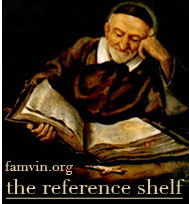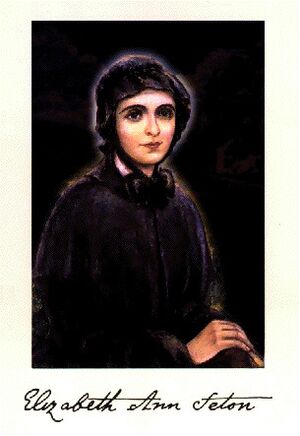Collected Writings of Elizabeth Ann Seton

ELIZABETH BAYLEY SETON: COLLECTED WRITINGS
From the INTRODUCTION
- “Elizabeth Seton did more for the Church in America than all of us bishops together.” Archbishop Francis Patrick Kenrick

On September 14, 1975, Elizabeth Ann Bayley Seton (1774-1821) became the first native of the United States of America to be canonized a saint of the Roman Catholic Church. This event focused attention for a brief time on a woman whose life was intertwined with many notable figures of the young republic and the growing Catholic church in America.
Elizabeth Seton’s education, family life, and social practice were typical of women of her class in late eighteenth century America. In her early life in New York, she mingled with figures of post-Revolutionary society, religion, government, and business. As a devout Episcopalian wife and mother, she was a founding member of the first benevolent society in the United States initiated and directed by women. Her conversion to Catholicism in 1805 brought her to the attention of such priests as John Carroll, John Cheverus, and Louis Dubourg, who came to view her as an instrument, even a partner, as they sought to shape the emerging identity of the American Church. The school which she began in Emmitsburg, Maryland, in 1810 educated the daughters of prominent families, Catholic and non-Catholic alike, from Baltimore, New York, Philadelphia, and elsewhere as well as children of the poor and working class. Her personal magnetism and spiritual depth sustained lifelong networks of friendship that spanned oceans and decades. Among American women of her time, particularly Catholic women, she is one of the earliest for whom substantial documentation is available.
But, despite Elizabeth Seton’s prominence in the history of American Catholicism, there has been little critical scholarship about her. One major reason has been the difficulty of accessing relevant documents since her writings are located in a number of archives throughout North America. Another reason is that American Catholic historiography until recently paid little attention to the contributions of women and lay people in general. Finally, Elizabeth did not compose the theological tracts or compendia of spiritual teachings that historians would have been likely to notice. Rather, she wrote letters and journals, women’s traditional medium of communication, singularly revealing, but often overlooked.
THE HISTORY OF THE PROJECT
The Sisters of Charity Federation in the Vincentian-Setonian Tradition, previously the Elizabeth Seton Federation, is an association of women’s religious congregations in the United States and Canada which trace their roots to Mother Seton’s 1809 foundation of the Sisters of Charity in Emmitsburg, Maryland, or which follow the rule of St. Vincent de Paul and St. Louise de Marillac. The Federation was organized in 1947 primarily to promote Elizabeth Seton’s cause for canonization. Several decades earlier, Charles Souvay, C.M., had laid the groundwork by compiling all of Elizabeth’s then known writings. In 1938 with the appointment of Salvator Burgio, C.M., as American Vice-Postulator and the formation of the Mother Seton Guild, the cause gained momentum. Elizabeth Seton was declared Venerable in 1959, beatified in 1963, and canonized in the Holy Year of 1975.
In 1992 the Federation sponsored the first Seton Legacy, a major research conference on the life and spirituality of Elizabeth Seton, in which the co-editors and manuscript editor of the present work were involved. Subsequent Seton Legacy conferences were held in 1996-1997 and in 2001.
Presenters at the 1992 conference pointed out the difficulty of locating the various Seton papers preserved in a number of archives. It was evident that further research would be greatly aided by the publication of the complete corpus of Seton writings. As a result, in 1993 the Federation authorized a committee of Sisters of Charity to begin this work. Its first members were Regina Bechtle, (New York), Mary Louise Brink (Halifax), Theresa Corcoran (Halifax), and Judith Metz (Cincinnati), all of whom combined scholarly expertise with a deep desire to spread knowledge of Elizabeth Seton.
Phase I of the project sought to locate and identify all original Seton writings. Written inquiries verified that original letters, journals, notes, translations, and other material existed in twelve archives, with the largest collection at St. Joseph’s Provincial House, Emmitsburg, Maryland. Additional materials were later discovered in six more archives or libraries. As a useful tool for researchers and a step toward publication of the writings, an annotated list of the holdings in all archives was prepared. This list was published in several installments in Vincentian Heritage, a journal of the Vincentian Studies Institute, beginning with volume 18, number 1 (1997).
In March 1996, Ellin M. Kelly, professor emerita at DePaul University, Chicago, joined the committee as manuscript editor. Dr. Kelly took over the formidable task of transcribing newly found material and verifying the accuracy of existing transcriptions. Sisters Regina Bechtle and Judith Metz were named co-editors of the project in the spring of 1996. They assembled the Advisory Committee with representatives from each of the six congregations which traced their roots to the community founded by Elizabeth Seton in Emmitsburg in 1809. Other scholars who have served on the committee include Kathleen Flanagan, S.C., (Convent Station, NJ); Anne Harvey, S.C., and Elizabeth Bellefontaine, S.C., (Halifax, NS); Vivien Linkhauer, S.C., (Greensburg, PA); and Betty Ann McNeil, D.C., (Emmitsburg Province).
PREVIOUS STUDIES
Rev. Charles I. White wrote Life of Mrs. Eliza A. Seton (New York, 1853), the first full-scale biography of Elizabeth Seton, thirty-two years after her death. White’s work was translated and adapted by Madame Hélène Bailly de Barberey and published in French as Elizabeth Seton et Les Commencements de L’Eglise Catholique aux Etats-Unis (Paris, 1868). After six French editions Msgr. Joseph B. Code translated de Barberey’s work back into English as Elizabeth Seton by Madame de Barberey Translated and Adapted from the Sixth French Edition, adding newly discovered material. Inevitably, the two processes of translation resulted in some deviations from White’s biography and the original sources on which it was based.
Sisters of Charity played an early and significant role in advancing Seton scholarship. New letters were published in the Life of Mother Elizabeth Boyle of New York by Maria Dodge, S.C. (New York, 1893). In her 1917 History of Mother Seton’s Daughters Mary Agnes McCann, S.C. (New York, 1917), brought to light new documents from archives in Baltimore and Cincinnati. Rose Maria Laverty, S.C., traced the saint’s Bayley and Le Conte ancestry in Loom of Many Threads (New York, 1958).
In her 1950 dissertation at The Catholic University of America on the life of Elizabeth Seton, historian Annabelle Melville made extensive use of the Seton manuscripts. Subsequently published as Elizabeth Bayley Seton, 1774-1821 (New York, 1951), this book has come to be regarded as the definitive scholarly biography of the saint. Melville with Ellin Kelly edited Elizabeth Seton: Selected Writings (New York, 1987) and thereby introduced a wider audience to the depth of Mother Seton’s spiritual life. Until the publication of the current work, this study represented the most comprehensive publication of Seton writings available. Dr. Kelly, manuscript editor for the present volumes, has made numerous major contributions to Seton scholarship over the years, notably as compiler and editor of Elizabeth Seton’s Two Bibles: Her Notes and Markings (Huntington, IN, 1977) and Numerous Choirs: A Chronicle of Elizabeth Bayley Seton and Her Spiritual Daughters (2 vols., Evansville, IN, 1981, 1996).
Marie Celeste Cuzzolina, S.C., brought to awareness Elizabeth Seton’s skill as a translator by editing her translation of the eighteenth-century spiritual classic by Ambroise de Lombez, O.F.M., Cap., A Treatise on Interior Peace (Staten Island, NY, 1996). Papers from the first two Seton Legacy symposia on the significance of Elizabeth’s life and spirituality have been published in Vincentian Heritage, [14 (1993) and 18 (1997)]. Papers from the 2001 conference were privately published, as were papers from the Elizabeth Seton Symposium sponsored by the Sisters of Charity of Cincinnati in 2002.
Besides Melville’s dissertation six others have dealt with aspects of Elizabeth Seton’s life. Kathleen Flanagan, S.C., studied the influence of Rev. John Henry Hobart (Union Theological Seminary, 1978). Rose Marie Padovano, S.C., explored Elizabeth’s ministerial leadership qualities and educational innovations (Drew University, 1984). Gail Giacalone used Elizabeth’s experience as a case study in loss and bereavement (New York University, 1987). Jenny Franchot analyzed the ante-bellum encounter of American Protestants with Catholicism through the writings of Elizabeth Seton and other converts (Stanford University, 1986). William Jarvis focused on Elizabeth and the early Sisters of Charity to critique the influence of religion on nineteenth century women (Columbia University, 1984). Judith Metz, S.C., studied Elizabeth’s life as a woman of the early Republic in New York (The Union Institute, 2000).
Works in a more popular and reflective vein which have also drawn on many of the Seton manuscripts include Letters of Mother Seton to Mrs. Julianna Scott by Joseph B. Code (New York, 1960); Mrs. Seton: Foundress of the American Sisters of Charity (New York, 1962, 1975) and The Soul of Elizabeth Seton: A Spiritual Portrait (San Francisco, 1990) both by Joseph Dirvin, C.M.; Praying with Elizabeth Seton by Margaret Alderman and Josephine Burns, D.C. (Winona, MN, 1992); Elizabeth Ann Seton: a Woman of Prayer (New York, 1993), The Intimate Friendships of Elizabeth Ann Bayley Seton (New York, 1989), and Elizabeth Ann Seton: A Self-Portrait (Libertyville, IL, 1986), all by Marie Celeste Cuzzolina, S.C.; A Retreat with Elizabeth Seton: Meeting Your Grace by Judith Metz, S.C. (Cincinnati, 1999); and 15 Days of Prayer with Elizabeth Seton by Betty Ann McNeil, D.C. (Liguori, MO, 2002). These works, of necessity, have been able to select only a small sample of Elizabeth’s letters, personal journals, meditations and instructions to her sisters. The majority of the Seton manuscripts have never been published in full or in part. With the publication of this comprehensive and chronologically arranged edition of Elizabeth Seton’s writings, the full depth of her spirituality and the breadth of her achievements and relationships over her short lifetime are finally accessible to the interested reader and serious researcher alike. An authentic portrait can begin to emerge of Elizabeth Bayley Seton as a woman firmly rooted in her times, yet able to transcend them.
THE STRUCTURE OF THE WORK
Volume One consists of Elizabeth Seton’s letters, journals, and notes from 1793 through June 1808. Part I covers her life as an Episcopalian daughter, wife, and mother in New York from 1793, just before her marriage, until October 1803, when she sailed for Italy with her ailing husband and her eldest daughter, Anna Maria. Part II (October 1803 to June 1804) includes the journal and other material written on the Italian journey during which her husband died. Part III (June 1804 to July 1805) contains the journal of her spiritual conflict and conversion on her return to New York. The last section, Part IV, includes letters, notes and the journal she kept after her conversion as a widow and mother in New York (July 1805 to June 1808).
Volume Two comprises Elizabeth’s time in Baltimore (Part V, June 1808 to June 1809) and her years as founder of the American Sisters of Charity of St. Joseph’s in Emmitsburg, MD. The writings in Part VI (June 1809 to December 1815) and Part VII (January 1816 to December 1820) shed light on her relationships with her children, the women who joined her in the formative years of the community, and the clerical leaders of the Catholic Church in early America. They also give compelling evidence of her maturing spirituality.
Volume Three includes notebooks, instructions, meditations, and a variety of other material spanning Elizabeth’s entire life. Part VIII contains material she copied or wrote as a Protestant, 1791 to 1805. Her writings after she became a Catholic are divided into instructions and meditations written for the Sisters and students (Part IX), notebooks of copied and excerpted material from spiritual writers, some interspersed with her own comments (Part X), and personal reflections, prayers, verses, jottings, and inscriptions, some written in books or on holy cards (Part XI). The latter part includes a substantial excerpt from Elizabeth Seton’s Two Bibles (Kelly), demonstrating her familiarity with and reliance on Scripture. Records from 1809 to Elizabeth’s death in 1821 (Part XII) shed light on the structure and the daily life of the community and of St. Joseph’s Academy. The section on translations (Part XIII) is significant for an understanding of the spirituality that Mother Seton bequeathed to her young community. Included is a summary of her translation of A Treatise on Interior Peace (ed. Cuzzolina).
Appendix A contains several documents of interest to researchers: apologetic treatises written by Filippo Filicchi and John Henry Hobart, important as Elizabeth considered conversion to the Catholic Church; a list of students at St. Joseph’s Academy during Elizabeth’s life; the Rule and Constitutions that shaped the early years of the Sisters of Charity of St. Joseph’s and a note Rev. Simon Bruté wrote encouraging the Sisters to preserve Elizabeth’s writings. Appendix B contains a table of Seton artifacts, a table of the books known to have been used by Elizabeth which abundantly substantiates the claim that Elizabeth was a well-read and cultured woman, and several documents discovered since the publication of Volumes One and Two. An errata for Volumes One and Two is also included.
A NOTE ON SOURCES
Simon Bruté noted that sometime after 1817 Elizabeth Seton destroyed her papers. He asked to keep some of them in order to understand the Protestant faith that had formed her. Since Elizabeth’s death in 1821, her remaining papers have found their way by circuitous routes into numerous archives, including but not limited to those of the original congregations that stemmed from her Emmitsburg foundation. The Seton-Jevons Collection is one example. These family letters formerly in possession of the Jevons family, Elizabeth’s great-grandchildren, were given to the Mother Seton Guild, which promoted the Seton cause for canonization. Subsequently, they were distributed among various Sisters of Charity archives by Salvator Burgio, C.M., who also gave photostats of the letters back to the donors. A fire at the motherhouse in 1951 destroyed manuscripts the Sisters of Charity of Halifax possessed. In 1967 the last direct descendant of Elizabeth Seton, Ferdinand Jevons, willed the bulk of his photostats to the Sisters of Charity of New York. Thus the present volume includes both original manuscripts and copies under the designation “Seton-Jevons.”
At the University of Notre Dame, Notre Dame, Indiana, in addition to the Seton Collection, there is also a “Souvay Collection” (designated as UNDA MSVY). This contains typescripts and photostatic copies of Seton letters used by Charles Souvay, C.M., who was one of the first to collect Elizabeth’s writings in connection with her cause. Material from the Souvay Collection has been included in this volume when the original could not be located.
Elizabeth’s letters, sayings, etc., compiled by Simon Bruté, S.S. (ASJPH 1-3-3-12:99 and 12:102), and her letters to George Weis copied by her nephew Bishop James Roosevelt Bayley (ASJPH 1-3-3-2:76) were also used for this volume.
Many Seton manuscripts have simply disappeared. Only fragmentary citations survive in early works by Simon Bruté, Charles I. White and Msgr. Robert Seton, Elizabeth’s grandson. Internal evidence in letters written by some of her correspondents, including Bishop John Cheverus and Rev. John Henry Hobart, indicates that additional Seton letters once existed. In these cases the editors made every attempt to locate the original manuscripts. Where this proved impossible, a typescript or transcription from an archival photostat or printed source was used, and this is indicated in the accompanying notes.
A FINAL NOTE
This project of the Sisters of Charity Federation is focused on making the Seton writings accessible in as close a form as possible to the original manuscripts while at the same time providing adequate information to situate the writings in context. These volumes provide scholars with much material for further research. Yet to be probed in depth, for example, are themes such as the trajectory of Elizabeth’s spiritual development; the influence of political, intellectual, and religious movements of her day; her philosophy and practice of education; her exercise of leadership; and the manner in which she adopted or transcended the conventional role of women. Those who guided this project to completion share the hope that these volumes will mark the beginning of a new and fruitful phase of exploration into the life of Elizabeth Bayley Seton, wife, mother, widow, convert, educator, founder, and saint.
Elizabeth Bayley Seton: Collected Writings.
Edited by Regina Bechtle, SC, and Judith Metz, SC; manuscript editor, Ellin Kelly.
Vol. I, Correspondence and Journals, 1793-1808 (563 pages, $49);
Vol. II, Correspondence and Journals, 1808-1820 (786 pages, $59);
Vols. IIIa
Parts of this work are available online: famvin.org/seton.
